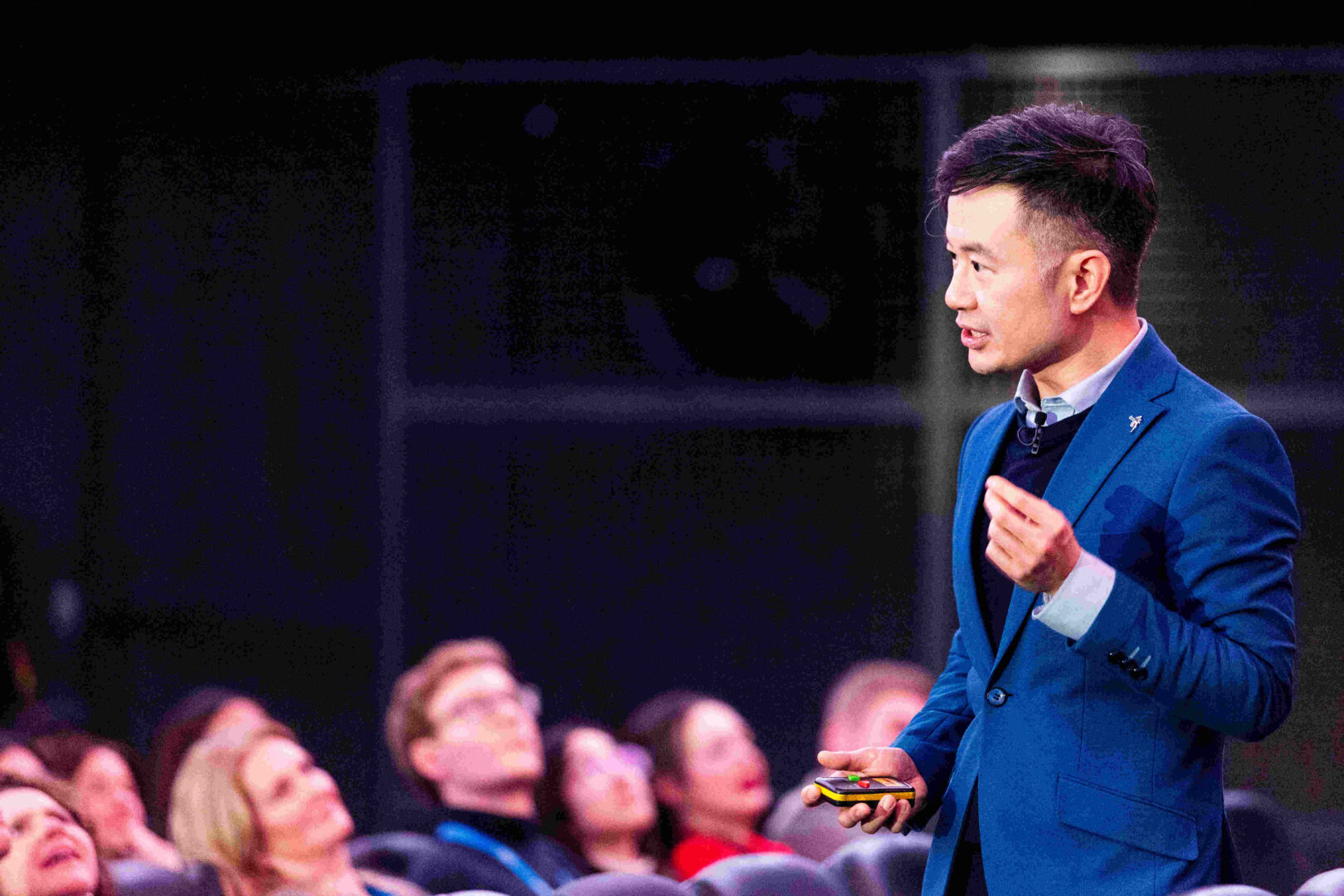“What you know from the past is so critical for you to navigate the future.”
How do some companies have the stamina to endure for decades, while others are one-hit wonders, their fortunes rising and falling in the blink of an eye? That was the starter for 10 at the IMD Global Future Readiness Forum, organized in partnership with Merlin Entertainments and CNBC.
Industry experts gathered at London’s famous Madame Tussauds to hear Howard Yu, LEGO Professor of Management and Innovation and Director of the IMD Center for Future Readiness, describe what the leading companies in the pharmaceuticals, technology, and fashion industries are doing today to ensure success tomorrow.
Drawing upon the latest IMD Future Readiness Indicator, Yu invited the audience to consider the behavior of top companies that have sustained themselves in the long term, emphasizing three key principles for businesses to keep in mind as they look ahead to 2025.
Pursue meaningful expansion, not easy growth. Thoughtful expansion requires a focus on “one main thing,” and a clear priority to scale new capabilities.
Don’t forget your domain knowledge. The leading fashion companies, from Hermès to LVMH, all emphasized careful expansion and have never forgotten their roots, even while redefining what luxury is.
Embrace cognitive conflict with love.
While most companies intuitively understand how to perform and transform at the same time, the average company tends to flip between these two business modes. When times are good, they invest in the future; spending money on start-ups and new ventures and exploring new partnerships. When times are bad, however, they focus on bringing cash back to the bottom line and shutting down non-core activities.
“Companies that always stay future-ready can achieve both of these activities at the same time, meaning that whether times are good or bad, they focus on scaling up new capabilities ahead of others,” said Yu. “The trick is, of course, to have clear priorities.”
Thoughtful expansion
Take NVIDIA, which recorded $37.5bn in revenue for the current quarter, topping the list of technology companies on IMD’s Future Readiness Indicator, which measures seven factors, including financial fundamentals, and rolls them into a composite score. The software and fabless company surged ahead of Microsoft and Meta to take first place this year.
“How did NVIDIA grow so big, so fast, and so suddenly? They built up their cloud computing services, going after Microsoft’s customers like Roche, Novartis, and others,” explained Yu. “When a company makes so much money, your margin becomes someone else’s opportunity.”
By pursuing thoughtful expansion, NVIDIA chose to focus on one main thing that it knew it could scale up in a significant way to achieve success in the long term.
Domain knowledge
However, not all companies have performed as well. Take Nike, which has fallen from first to fourth place this year. Its shift away from its core performance-focused identity left consumers confused and partners alienated.
“It moved too much towards digital and forgot its past,” said Yu, noting the need for good conflict. “In making a decision, you don’t want too much conflict, and you don’t want too little. You want somewhere in between; that’s the sweet spot.”
Companies with high-performing teams have extreme conflict, but this comes with an element of strong trust. Team members should be able to debate, but with love as opposed to artificial harmony where everyone smiles, but no one agrees – and no changes are made.
“As you scale up, do not forget about your roots,” said Yu. “A lot of the time, in the search for new capabilities and digital transformation, the danger for companies is we de-emphasize our domain knowledge. What you know from the past is so critical for you to navigate the future.”
The next platform?
In a series of in-depth panels, industry experts from fashion, technology, tourism, and hospitality shared insights on how their organizations plan for future readiness.
Ian Edwards, Director of UK Agencies and Head of Connection Planning EMEA at Meta, highlighted the importance of seeing crises as opportunities. “If you look back through history at crises as they happened, you see more core businesses being creative in that period –[which created] incredible opportunities.
“We are about to live through a huge AI-driven third or fourth industrial revolution. We live in a connected world now. You can start to have ideas and scale your business further and faster than ever before. Bring those elements together and it’s super exciting.”
In another panel discussion, with Heathrow Airport Group CEO Thomas Woldbye, Tamara Lohan, Founder and CEO of Mr and Mrs Smith, and Spencer Holt, Chief Experience and People Officer at Merlin Entertainments, shared their thoughts on the changes they are seeing in the travel and tourism industry, highlighting customer demand for more experience-led services.
For Holt, future readiness was about transforming its business through new partnerships or finding new customer bases to stay relevant to its guests – including a new partnership with Minecraft, the world’s most popular game, which aims to bring what happens in the virtual world into the physical world, and vice versa.
“One of our biggest drivers to satisfaction at LEGOLAND is: Did you actually play with your kids?” he added. “We’re helping parents do that, build LEGO. Helping people have more meaningful experiences. One of LEGO’s growth markets is males over the age of 40. Next, we have the LEGO festival – bringing people in to have an experience. Digital’s great but sometimes it’s great to put that away and use your hands. How do you do that at Thorpe Park or Alton Towers or Sealife?”
For Lohan, predicting how different industries might impact tourism in the future is a key point to consider. He highlighted the impact of weight loss drugs like Ozempic in driving more interest in wellness experiences.
“As people get healthier and fitter, what does that mean for travel? Will it drive more people to explore locations, and what will they do when they get there? Yoga, (and the) wellness theme is here to stay,” she said. Lohan also foresees a rise in retreat and group hiking holidays, particularly among women, as people increasingly seek human connection in nature.
Woldbye emphasized the need to try and do things differently, thinking about alternatives for travelers and how to enhance a person’s journey. “How do we get growth without hurting the environment? It’s not about traveling less. Those three billion people, they’re going to travel. So, it’s not about limiting that,” he said. “It’s about trying to do it differently and thinking about alternatives.”
Conclusion
The path to future readiness demands more than short-term agility – it requires a deliberate focus on thoughtful growth, a deep respect for core expertise, and a culture that fosters bold innovation with constructive dialogue. Enduring success lies in the ability to scale new capabilities while staying true to our foundational strengths.
As industries evolve and external pressures mount, the organizations that thrive will be those that see challenges as opportunities and embrace change with purpose. By cultivating clear priorities and fostering collaboration built on trust, businesses can navigate uncertainty and position themselves to lead not just today, but well into the future.



